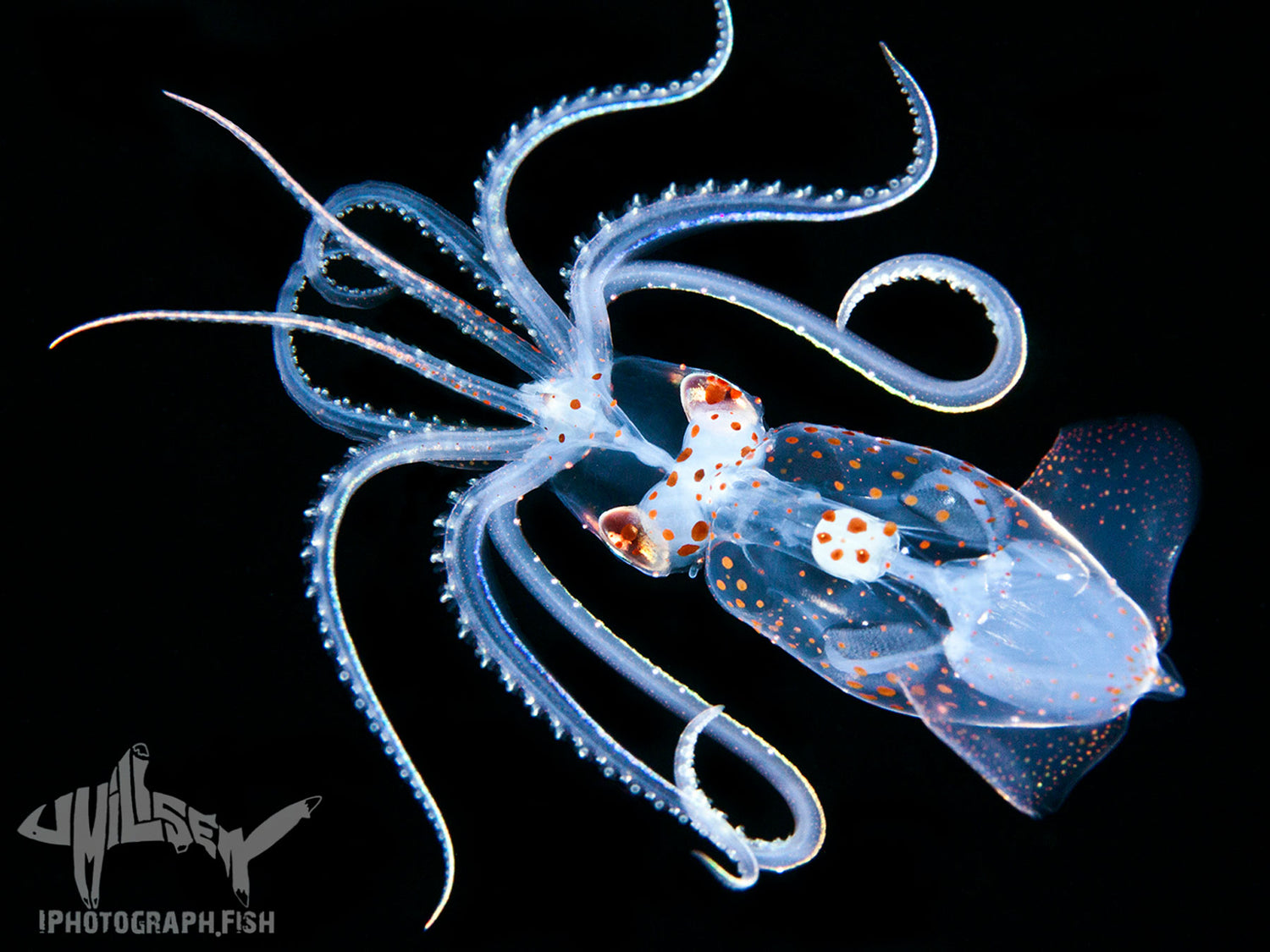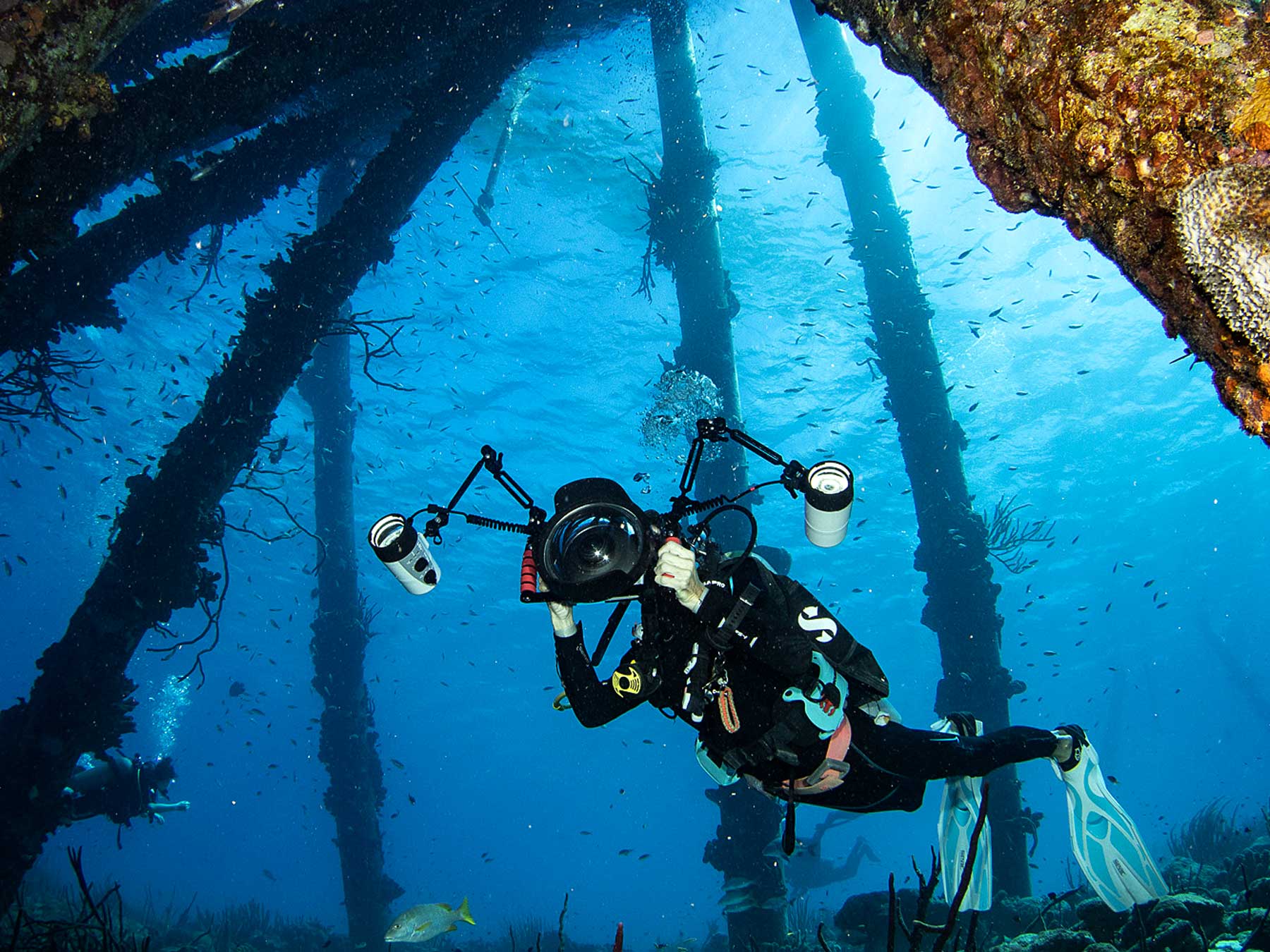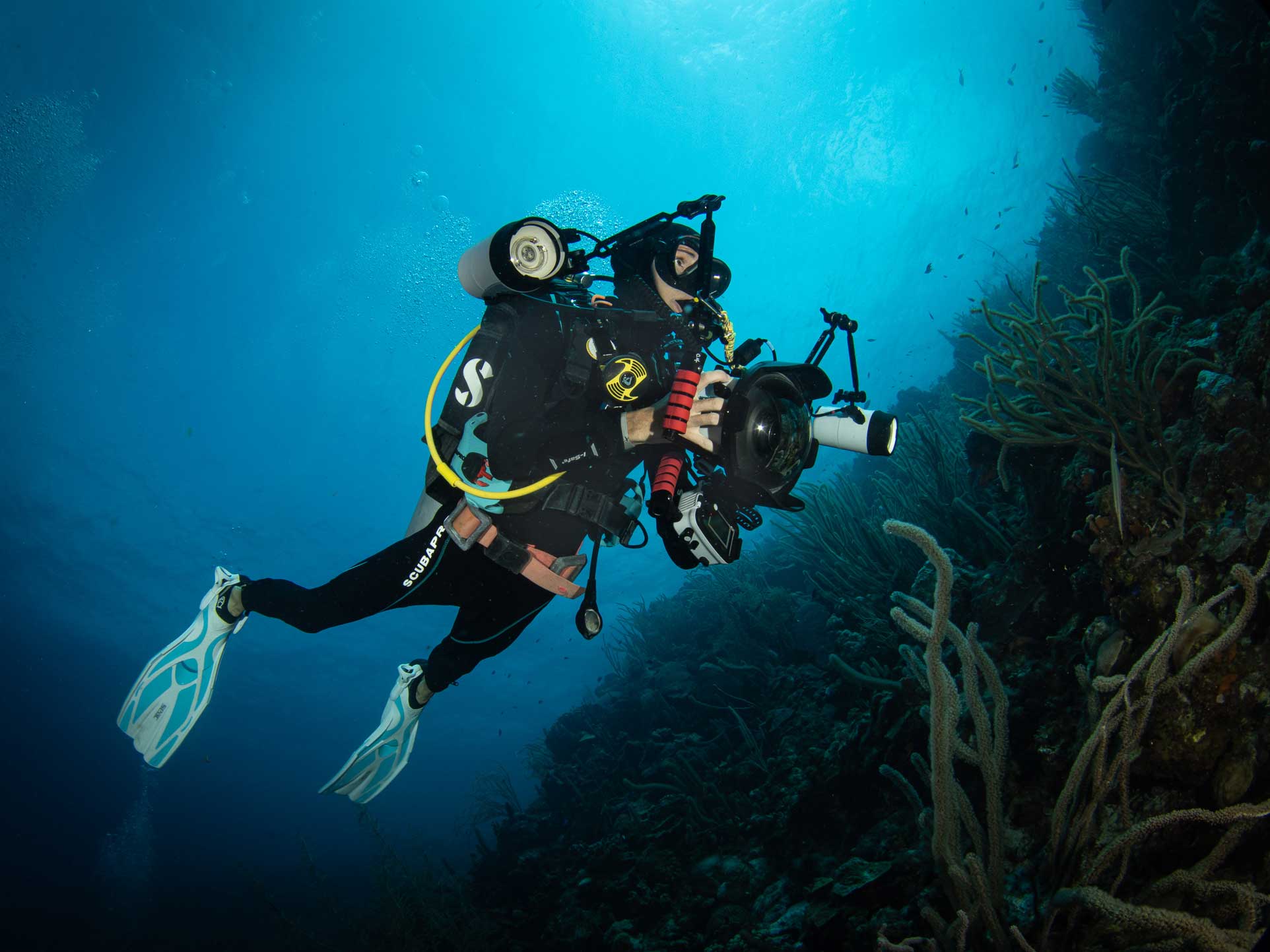By Jeff Milisen
In the early 1980’s, a select few divers got curious as to what lurked offshore from Kona at night. They would famously take their boats many miles offshore at night, alone, grab a bow line, jump in, and drift over top of water that was thousands of feet deep. Improvements have been made (thankfully) that made the dive safer and paved the way for today’s latest craze: recreational blackwater diving.
You aren’t supposed to feel comfortable while drifting over blackness. We are only kept alive by expensive life support equipment, and even then we only have about an hour before we have to surface. And while we flubber about, the surrounding world is stuffed with life that we can barely see, but it is highly adapted to survive where we struggle. This is the realm of actual sea monsters, and most of them are smaller than your pinky nail.

Peneid • ISO 400 • f/14 • 1/160 • A lot of what makes blackwater images so appealing is the tack-sharp focus of unusual subjects. Shrimps are super common, but focusing on the minute details makes the shot. • Photo Copyright © 2020 Jeff Milisen
If you have never tried it, drifting through ocean with no visible bottom can be an acutely bizarre experience. Even with the improvements to dive protocols, it is meant to take a diver-and photographer- out of their comfort zone.
Where to go
What started in Kona has since caught on to include other areas such as Florida, the Phillippines, Palau, Maldives, Roatan, and Japan. If you are traveling somewhere, it doesn’t hurt to ask if they offer or will support a special blackwater drift. The worst they can say is no. As far as where is best, I am admittedly biased toward my hometown of Kona.
Gear up!
The low contrast environment of blackwater is one of the last places where mirrorless camera focusing systems can’t compete with DSLRs. Regardless of the brand, the pros stick with cropped sensors. Sensor size is less important, however, than the choice of lens. With a few exceptions, most blackwater photography is shot through a 60mm macro lens for two reasons: they are fast at focusing and the short minimum focal distance helps with one of the trickiest parts of this type of photography: finding tricky subjects in the viewfinder.

Hippocampus and squid • ISO 400 • f/8 • 1/125 • It is one thing to check “larval octopus” or “pelagic seahorse” off of a bucket list. But to see them interact is priceless. Photo Copyright © 2020 Jeff Milisen
Lighting
Selecting the right lights and strobes is just as important as finding the right camera/lens combo. You will eventually find a use for 2 kinds of light: focus and spotting. A good focus light will have a wide beam for help in finding creatures across a wide focal plane. The brighter the focus light, the more contrast the subject will have, making focusing a breeze. Therefore, focus lights should be at least 1200 lumens. A good spotting torch such as the Ikelite Gamma will have a tight, focused beam to help pierce the darkness whilst hunting for the next target.
Settings
Exposure
I try to splash with the camera set to 1/200 sec, f/10, iso 400 and then adjust for the subject. Some photographers prefer to shoot with a tighter aperture and higher iso for more depth of field, and while that can work to achieve a nice shot, I find the resulting restriction of light to be deleterious to the final image. You are welcome to play around here until you find a base setting that works for you.

Lamprogrammus • ISO 200 • f/10 • 1/160 • I call this sort of thing the “X-factor.” Because we all want to see the few animals on the hit list, but the really special encounters are the ones are unimaginable until it happens. Blackwater in Kona isn’t about target diving or expecting to photograph an animal. It is about the full diversity of the sea. • Photo Copyright © 2020 Jeff Milisen
Focus
Modern SLR autofocus systems tend to be pretty good. I use autofocus set to “Al servo” and a large focal field. Some photographers, especially those using older equipment or mirrorless cameras, have had some luck setting the manual focus to a few inches in front of the port and then manually moving the camera back and forth until the eye of the subject is in focus.
Flashes
Strobes can be a tricky beast. For simplicity, I find that Ikelite’s TTL gear seems to expose the majority of subjects quite nicely. Manual strobe shooters will be adjusting frequently between full power for the clear subjects and low power for the highly reflective fishes and squids. Regardless of the setting, the strobes should be positioned behind the plane of the front port and aimed pretty close to directly at the subject. A good rule of thumb is that the strobes should roughly be as far away from the lens as the lens is from the subject.

Ommastrephes • ISO 200 • f/8 • 1/200 • Reflections are especially difficult, but they can take an otherwise interesting subject and giving it a setting that shows a different side of the scene. The surface is a challenging place to work, but the payoff is huge. Perfect buoyancy and patience are key to making it work. • Photo Copyright © 2020 Jeff Milisen
Finding the animals
The secret to excelling at blackwater is to let the subjects speak for themselves. I find it is best to take the time to find the outstanding animals, then simply expose them properly. The majority of subjects are very small. I like to think of it like a muck dive but without the muck. Which brings me to my first piece of advice: look small! If you are expecting megafauna, you are going to miss all of the macro life that makes this dive worth it!
Next, I tell all of my guests to look all throughout the water column. A large percentage of divers want to go as deep as they can. Sometimes the deeper water can yield something different, but the vast majority of life is going to be within the top 10 feet of water. When given the choice, I will often spend my whole dive right at the surface.

Stenella • ISO 400 • f/7.1 • 1/125 • Dolphins and other megafauna are an uncommon treat on blackwater. Because they are big, fast moving, and in low light, they are a real challenge to shoot through a macro lens on a blackwater dive. Start by putting your focus lights and strobes out away from your lens. Nudge open your aperture a little to let more light in. Pre-focus on something distant like your buddy so your lens is at least close to the focusing distance of the subject. That way, it will spend far less time hunting for focus. The final ingredient is pure luck. Photo Copyright © 2020 Jeff Milisen
My final piece of advice is going to sound selfish, but don’t feel obliged to share you subjects with others. That is what a guide is for. Often, fast-moving subjects like squids and fishes will get caught off-guard and freeze like a deer in headlights. The moment you turn to your buddy to get their attention, that animal is going to ghost you. A better way to handle it is to nerd out on the animal yourself and trust that your buddy will find their own subjects.
Conclusion
Don’t get frustrated! It is perfectly normal for even highly seasoned underwater photographers to come away from their first blackwater without much to show for it. It often takes newcomers a whole dive just to figure out their buoyancy! It just takes some time in the water and practice to achieve crisp, stellar results.

Xiphias (larval) • ISO 400 • f/11 • 1/160 • If you do enough of these, you will eventually see larval billfish. But travellers come from all over the world to fish for big ones. It is my opinion that swimming with an adult billfish is far more exhilarating than catching one. Photo Copyright © 2020 Jeff Milisen

Xiphias (adult) • Tokina 10-17mm • ISO 100 • f/7.1 • 1/125
 Ambassador Jeff Milisen is an internationally acclaimed underwater photographer who has specialized in blackwater photography since 2009. He is a recent addition to the Ikelite ambassador team. His upcoming book, a Field Guide to Blackwater Diving in Hawaii, will help both newbies and seasoned blackwater veterans identify the strange animals they encounter. He currently shoots with a Canon EOS 7D Mark II and dual Ikelite strobes. Read more...
Ambassador Jeff Milisen is an internationally acclaimed underwater photographer who has specialized in blackwater photography since 2009. He is a recent addition to the Ikelite ambassador team. His upcoming book, a Field Guide to Blackwater Diving in Hawaii, will help both newbies and seasoned blackwater veterans identify the strange animals they encounter. He currently shoots with a Canon EOS 7D Mark II and dual Ikelite strobes. Read more...
Additional Reading
Super Macro Underwater Photography Techniques
Macro with Black Background Underwater Camera Settings
Fluorescence and Luminance Underwater Photography
Canon Rebel SL3 and Tokina 10-17mm Fisheye Underwater Photos













